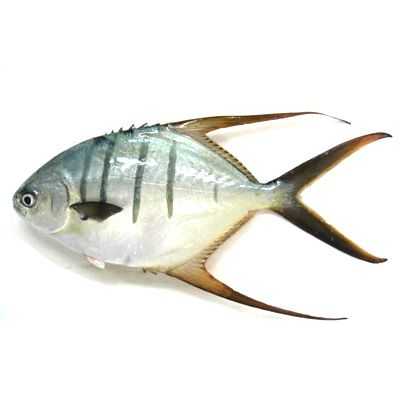Gafftopsail Pompano

Species Details
Trachinotus Rhodopus
Carangidae
Perciformes
Reef
5 - 8 lbs.
17" - 24"
Gafftopsail Pompano (Trachinotus rhodopus) Fish Description
A Gafftopsail Pompano is an inshore first known for its diamond-shaped, compressed body. It is mostly silver in color with four to six bars on its sides, ranging from yellowish to brownish shade. Its snout is extendable and pointed, and its caudal fin is slender with a ‘V’ shape. Its body is covered with scales, and its lateral line appears to be slightly arched over its pectoral fins.
The Gafftopsail Pompano is often mistaken as the Palometa (Trachnotus goodei). Its distinguishing factor is its body and fins; its body is rounder, and its fins are lighter.
Diet & Size
The Gafftopsail Pompano feeds on small invertebrates like benthic worms and gastropods, crustaceans like shrimp and crabs, and smaller, bony fishes. A Gafftopsail Pompano is usually 9.8 inches in length but can grow up to 24 inches.
Interesting Facts
- The Gafftopsail is often mistaken as the Palometa. In 2013, up to 70 people were bitten on their toes and fingers on what was said was by a Pompano. However, it was actually a fish they called ‘palometa,’ which is a general or common name for piranha-like species in South America.
- This fish is often sold in the market, either fresh or dried and salted.
- A fish farm in Florida is farm-raising eggs of Gafftopsail Pompano.
- This fish species is one of the most beautiful fishes found in Mexico waters. There’s a commercial interest for them since they look good as ornamental species in public aquariums and others with larger displays.
- The most famous preparation of this beautiful fish is en papillote or cooking it in parchment.
Fishing Techniques: How to Catch a Gafftopsail Pompano
A Gafftopsail Pompano is one sought-after fish species because it’s an excellent game fish with fantastic speed and will put up a great fight. Other anglers compare it to a Crevalle Jack’s pull considering their size difference.
There are multiple fishing techniques to catch a Gafftopsail Pompano. You can either go for still fishing, fly fishing, or drift fishing.
You can still fish and catch a Pompano with a light surf spinning or light bait baitcasting tackle. Something that weighs around 6 – 8 pounds is good enough. For fly fishing, you can use flies that sink well. Those Bonefish-type with lead eyes and epoxy heads would do just nicely.
You can also try drift fishing by chartering a boat for offshore fishing the entire day and let it take you to nearby wrecks or reefs. You can use smaller live baits such as small sand crabs, fiddler crabs, or live shrimps. You can also use dead clams and squid cuts. Artificial jigs are also good options, especially quarter or half-ounce jigs with short nylon skirts.
It is essential to know the water temperature before fishing Pompano because they quickly swim off to waters with a better temperature, especially between 70 and 80 degrees Fahrenheit. In Florida, they are abundant between April and May and again during November and December.
Habitat and Distribution
The Gafftopsail Pompano is mostly found and is abundant in Mexican waters of the Atlantic and Pacific Oceans. It prefers clear, tropical waters with temperatures between 70 to 80 degrees Fahrenheit.
This fish species is both pelagic and demersal but is often found inshore around reefs and sandy bottoms or around rocky offshore islets. They frequent waters with depths up to 100 feet.







